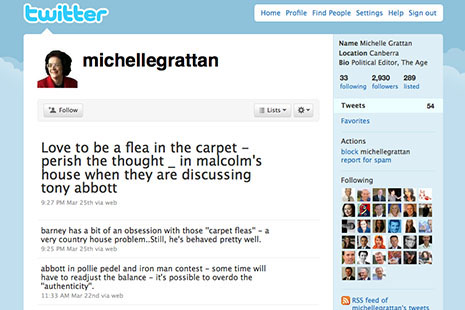LIBERAL SENATOR Simon Birmingham was slogging through a committee inquiry into the government’s Energy Efficient Homes Package last Thursday. Late in the afternoon he found himself thinking of Breakfast at Tiffany’s. This was because “the witness at the table [was] called Miss Golightly.”
At around the same time, in a different part of Parliament House, 2GB reporter Sarah Wiley noted with approval that “a little honey makes a fruit hot cross bun even sweeter.” And several hours later, an amusing thought crossed veteran Age journalist Michelle Grattan’s mind: she would “love to be a flea in the carpet – perish the thought – in Malcolm’s house when they are discussing Tony Abbott.”
We know these things because they were written on Twitter, by these people, in real time. Twitter is the newest of the “new” or “social” media, and many federal parliamentarians and Canberra press gallery journalists are picking it up with enthusiasm.
The politicians know they should do it, but most are not sure why. One MP freely admits he “tweets” (the verb of “twitter”) only so he is counted as one who tweets. At the other end, some MPs talk in terms of direct democracy and empowerment.
Prime Minister Kevin Rudd is easily the most read tweeter in the building, attracting almost a million “followers” – people who choose to receive his messages of 140 characters or less. In fact, on this measure he is the fourth most popular national leader in the world. Per capita of population Rudd jumps to third place, after Jordan’s Queen Rania and the vice-president of the United Arab Emirates, and two places ahead of Barack Obama. This impressive achievement obviously means… what? Nobody really knows.
Currently, fifty-four federal politicians have twitter accounts. A few have never tweeted a word, others type something every few months and some do it daily – plugging messages, attacking the other side or linking to columns they’ve written or to interviews they’ve just given or are about to give.
Liberal MP Scott Morrison is a polished tweetmeister. His spelling is faultless; his sentences have beginnings, middles and ends. As immigration spokesman he tweets, as you would expect, on the latest boat arrivals and other political talking points, but he also has an entertaining ongoing “bickering couple” riff with union boss Paul Howes.
Many in the press gallery use twitter to spruik their latest column or upcoming radio interview. They comment on policy and politics and relay what’s happening in the building. Meals, babies and love lives also get mentions. Grattan is the most senior of the journos who tweet, and she does it sparingly. (Someone calling themselves “Laurie Oakes” began tweeting this week but it may not be him.) The most followed, and perhaps most prolific, is Latika Bourke of 2UE.
Last year’s Liberal leadership change was a turning point in the gallery’s use of twitter. As Malcolm Turnbull’s leadership collapsed, the twittersphere shifted to overdrive, with goings-on in the building quickly retold online. Liberal MPs sent text messages to journalists from party-room meetings. They have been doing this for years, but now their words were instantaneously relayed to the world. Tweeters around the globe knew what was happening more quickly than some of the journalists in the building.
It was after this experience that many in the press gallery decided this fad wasn’t going anywhere soon and they’d better get on board.
Currently, thirty-one gallery journalists tweet (thirty-two counting “Laurie”), but that’s just those who put their name to it. Others have created pseudonymous accounts solely to follow the rest. In fact, it is likely that most, perhaps all, of the gallery either follow tweets themselves or have someone in their office doing it. The situation is presumably similar with parliamentarians.
The 140-character limit is the driver of Twitter’s nature and phenomenal uptake. Thankfully, blessedly, it forces people with strong opinions to be succinct. It facilitates quick dialogue and networking. It also encourages impulsive, pointless comments and mind-numbing glibness. Nothing’s perfect.
I am new to Twitter, only signing up several weeks ago when I commenced a twelve-month stint in the federal Parliamentary Library, where I am writing a monograph about the politicians and journalists’ use of “new media” in this election year.
A couple of weeks ago I gave a talk about my project. A preliminary discussion of what I was embarking on, it was well-attended by people from across the building: bureaucrats and staffers, even a few politicians. I thought it went well, but found out later that an audience member had been tweeting on me.
Her first tweet: “listening to a briefing about twitter at Aus parl library. Speaker’s ‘initial impressions’ unfortunately miss the point & opps :/.” Minutes later, I was apparently “making a lots of jokes about its triviality. Will be sending him some thoughts ;).” Then others from around the country joined in. Who was this blow-in, they demanded. “He’s only been tweeting for 2mins,” sniffed one, “that’s what you get when you invite ‘academics’ with near to zero experience in the medium,” complained another.
Did they have a point? Perhaps. I am here to learn. Any new communication fad attracts obsessives and evangelists. On the other hand, we humans are easily threatened by the new, and it’s always easy to knock.
Twitter is changing the political world. But some parts of that world evolve more slowly. Mr and Mrs Middle Australia and their plasma televisions in the outer suburbs and regions – these remain the ultimate goal of most major-party communication strategies. Effective soundbites and a good Laurie Oakes story on Channel Nine trump any number of twitter followers.
Reaching the swinging voters – the politically unengaged who from time to time temporarily become a captive audience by twiddling a knob or opening the newspaper – remains the main game in town. Everything else, Twitter, Facebook and blogs, are still means to that end. •





